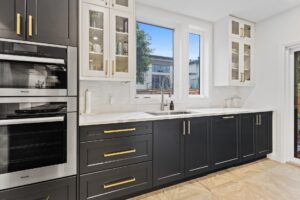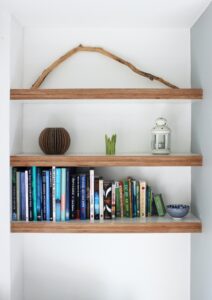Painting Kitchen Cabinets
Do you want to give your kitchen a fresh new look without breaking the bank? Painting your kitchen cabinets can be a cost-effective way to breathe new life into your space. Here are some tips and tricks on how to paint kitchen cabinets in a way that will make your kitchen look fabulous!
Preparation
Before you begin painting your kitchen cabinets, it is important to prepare the surfaces properly:
- Remove all cabinet doors, drawers and hardware.
- Clean the cabinets thoroughly with a degreaser to remove all dirt, grease, and grime.
- Sand the cabinets lightly with a sanding block to create a slight texture that the paint can adhere to.
- Repair any damage to the surfaces with wood filler.
- Tape off areas that you don’t want to paint such as the walls, countertops, and floors.
Materials needed
To paint your kitchen cabinets, you will need the following materials:
- Primer
- Paint (latex or oil-based)
- Paintbrushes (preferably a high-quality synthetic brush)
- Roller (optional)
- Sanding block
- Wood filler
- Screwdriver
- Drop cloths
Color options
When it comes to painting kitchen cabinets, the color options are endless. However, you need to consider the overall theme of your kitchen, as well as the style and color of your appliances and flooring. Some popular colors for kitchen cabinets include:
- White: A classic choice that can make your kitchen feel bright and clean.
- Gray: A versatile color that can work with a variety of kitchen styles.
- Navy: A bold choice that can add drama and sophistication to your kitchen.
- Green: A calming and refreshing choice that can bring the outdoors in.
- Black: A sleek and modern choice that can make a statement in your kitchen.
With these tips on preparation, materials, and color options, you can transform your kitchen cabinets into a beautiful focal point in your kitchen. Happy painting!
Staining Kitchen Cabinets

If you’re looking to update your kitchen on a budget, staining your kitchen cabinets can be an excellent way to add a new look and feel to your space. Here are some tips and tricks on how to stain your kitchen cabinets in a way that will give your kitchen a fresh new look!
Preparation
Before you start staining your kitchen cabinets, there are a few essential steps to follow to prepare your cabinets for the process:
- Remove all cabinet doors, drawers, and hardware
- Clean the cabinets thoroughly with a degreaser to remove all dirt, grease, and grime
- Use sandpaper to sand the cabinets lightly and create a slight texture that the stain can adhere to
- Repair any damage to the surfaces with wood filler
- Tape off areas you don’t want to stain, such as the walls, countertops, and floors
Materials needed
To stain your kitchen cabinets, you’ll need the following materials:
- Stain (choose a color that complements your kitchen and its overall design)
- A bristle brush or cloth
- A clean rag for wiping off excess stain
- Drop cloths to protect your floors and countertops
- Sandpaper or sanding block
- Wood filler for any deep scratches or damage
Color options
When it comes to staining your kitchen cabinets, there are many color options available. Consider the overall look and feel you want for your kitchen before you start the staining process. Some popular options include:
- Dark brown: Creates a more traditional look and feel for your kitchen
- Gray: Makes your kitchen feel modern and on-trend
- White: Can be a refreshing change and brighten up your kitchen
- Red: Adds a pop of color and can make your kitchen feel fun and inviting
- Black: Adds drama and sophistication to your kitchen
With these tips and tricks, you can easily stain your kitchen cabinets and give your kitchen a new look and feel. Remember, proper preparation and materials usage are crucial to ensure the stain adheres and lasts a long time. Happy staining!
Refacing Kitchen Cabinets
If you don’t have the budget to replace your kitchen cabinets altogether, refacing them might be a perfect option. Refacing kitchen cabinets involves removing the old cabinet doors, drawers, and hardware and replacing them with new ones. Here are some tips and tricks on how to reface your kitchen cabinets in an affordable and effective way.
Preparation
As with any home renovation project, preparation is key. Before you start refacing your kitchen cabinets, here are a few essential things to keep in mind:
- Measure your cabinets accurately so that you order the right size doors and drawers.
- Clean the cabinets thoroughly with a degreaser to remove dirt, grease, and grime.
- Remove the old hardware and fill in any holes with wood filler.
- Sand the cabinet boxes lightly so that the new veneer can adhere properly.
- Tape off the areas you don’t want to be covered.
Materials needed
Here are the materials you’ll need to reface your kitchen cabinets:
- Wood veneer or laminate sheets
- Replacement cabinet doors and drawers
- New cabinet hardware
- A utility knife or scissors to cut the veneer or laminate sheets
- A router or table saw to cut the new cabinet doors and drawers to size.
Design options
When it comes to choosing a design for your refaced kitchen cabinets, the opportunities are endless. Here are some design options to consider:
- White or bright-colored cabinets can create a fresh, modern look for your kitchen.
- Wood grain veneers can add warmth and depth to your kitchen design.
- Glossy or metallic finishes can add a touch of glamour and luxury to your cabinets.
- Open shelving can make your kitchen appear more spacious and give it a chic, minimalist vibe.
- Glass cabinet doors can showcase your favorite dishes and add a touch of elegance to your kitchen.
With these tips, refacing your kitchen cabinets can be a cost-effective and efficient way to give your kitchen a new look and feel. Remember to take your time with the preparation process and choose a design that best fits your style and preferences. Happy refacing!
Adding New Hardware

If you’re looking for an easy and inexpensive way to update the look of your kitchen cabinets, adding new hardware is a great option. Here are some tips and tricks on how to add new hardware to your kitchen cabinets in a DIY-friendly way.
Preparation
As with any home renovation project, preparation is key. Before you start adding new hardware to your kitchen cabinets, here are a few essential things to keep in mind:
- Measure your cabinet hardware placements accurately so that your new hardware will fit perfectly.
- Choose hardware that complements your cabinet style and design.
- If you’re using knobs or pulls with a different screw placement, fill in the old holes with wood filler and sand them smooth.
- Remove the old hardware and clean the cabinets thoroughly with a degreaser to remove dirt, grease, and grime.
- Use a template or jig to ensure that your new hardware is installed in a consistent and level manner.
Hardware options
When it comes to choosing hardware for your kitchen cabinets, the options are endless. Here are some popular hardware options to consider:
- Kitchen cabinet knobs come in a variety of shapes, sizes, and materials, from brushed nickel to ceramic to crystal.
- Cabinet pulls, also called handles, come in many styles and finishes, such as bar pulls, cup pulls, and finger pulls.
- Kitchen cabinet hinges can be hidden or decorative, depending on your preference.
- Drawer slides can be side-mounted or bottom-mounted, and they come in various weight rating options.
- Decorative backplates can be added to knobs or pulls for a touch of elegance and dimension.
Adding new hardware to your kitchen cabinets is a quick and easy way to give your kitchen a fresh, updated look. With these tips and options, you can choose hardware that best fits your style and preferences. Happy hardware shopping!
Installing Pull-Out Shelves

If you want to make the most of your kitchen space, installing pull-out shelves is a smart way to do it. This DIY project can save you time and energy by allowing you to easily access your kitchen items. Here are some tips and tricks to help you install pull-out shelves in your kitchen.
Preparation
Before you begin, make sure you measure your cabinets accurately so that you can choose the right size of pull-out shelves. Here are some other essential things to keep in mind:
- Remove all the items inside your cabinet and clean it thoroughly.
- Make sure your cabinet is level and square, and check for any obstructions that may get in the way of your pull-out shelves.
- Choose a pull-out system that suits your needs, whether it’s a single or double pull-out shelf, or a full sliding system.
- If you’re installing multiple shelves, make sure they are level and aligned properly.
- Consider adding a lip to the front of the shelves to prevent items from falling off.
Materials needed
Here are the materials you’ll need to install pull-out shelves:
- Drill
- Screws and brackets
- Tape measure
- Pencil
- Level
- Pull-out shelves
Benefits of pull-out shelves
Now that you know how to install pull-out shelves, let’s talk about why they’re a great addition to your kitchen. Here are some benefits:
- Convenient access to your items and more efficient use of your cabinet space.
- Easier cleaning and organization of your kitchen items.
- Reduces strain on your back and knees as you don’t need to reach all the way inside your cabinets.
- Customizable to fit any size or shape of cabinet.
Installing pull-out shelves in your kitchen is a simple and effective DIY project that can enhance your kitchen’s functionality. With these tips and tricks, you’ll be able to take advantage of your cabinet space in a smart and efficient way. Good luck with your project!
Updating Cabinet Doors

If you’re looking to give your kitchen a fresh new look without the cost of a full renovation, updating your cabinet doors can make a significant impact. This DIY project is straightforward and budget-friendly, and it can be completed in a weekend. Here are some tips and tricks to help you update your kitchen cabinet doors.
Preparation
Before you begin, assess your current cabinet doors and determine which ones you want to update. Once you have decided, follow these steps:
- Remove all hardware including hinges and knobs
- Clean doors thoroughly with soap and water
- Sand the surface of the doors lightly to provide a better adhesive surface
- Apply painter’s tape to the areas where the doors will meet the cabinets to prevent excess paint from sticking
Materials needed
Here are the materials you will need to update your cabinet doors:
- Screwdriver
- Sanding block or sandpaper
- Paint or Stain (depending on which finish you prefer)
- Paintbrushes or rollers
- Painter’s tape
- New hardware including hinges and knobs (optional)
Design options
When it comes to updating your cabinet doors, there are many design options to choose from. Some popular options include:
- Painting them a new color for a dramatic change
- Refinishing them with a wood stain to enhance the natural wood grain
- Replacing them with glass doors for a modern touch
- Adding trim or molding to create a custom look
Updating cabinet doors is an easy and cost-effective way to give your kitchen a fresh new look. By following these simple steps and design options, you can create a design that suits your style and personality. Good luck with your project!
Installing Under-Cabinet Lighting
If you’re looking for a way to add some extra light to your kitchen and highlight your countertops, installing under-cabinet lighting may be the perfect solution. This project is a great DIY task for those with some electrical and DIY experience, and it can be completed in a day. Here are some tips and tricks to help you install under-cabinet lighting.
Preparation
Before you start, gather all the necessary tools and plan out where you want to install your under-cabinet lights. Here are some preparation steps to follow:
- Turn off power at the circuit breaker to avoid electrocution.
- Clean the area under the cabinets and remove any items that may get in the way.
- Plan out where to place your lights and mark the spots with a pencil or tape measure.
- Prepare power cords and connectors for your lighting system.
Materials needed
Here are the tools and materials you will need to install under-cabinet lighting:
- Under-cabinet LED light strips or fixtures.
- Mounting clips, screws, or adhesive tape to attach fixtures to cabinets or walls.
- Power supply and connectors for your lighting system.
- Wire cutters, strippers, and electrical tape to connect wires and make secure connections.
- A drill with bits and screwdrivers to make holes and secure fixtures to cabinets or walls.
- A voltage detector to make sure wires are not live.
Installation
Once you have gathered all the necessary tools and materials, it’s time to start installing your under-cabinet lighting. Here’s how:
- Connect your power supply to the first light fixture, and then string the rest of the lights together if using multiple lights.
- Attach the light fixtures to the cabinet bottoms using the clips, screws, or adhesive tape.
- Drill a hole through the cabinet back if necessary, and feed the cord through the hole to plug into the power source.
- Connect the cord from the power supply to the electrical outlet.
- Turn the power back on and test the lights to ensure everything is working correctly.
Installing under-cabinet lighting can not only add extra light to your kitchen workspace but also create a cozy and inviting ambiance. Just be sure to follow all the instructions carefully and take safety precautions when dealing with electrical components. Good luck with your project!

I’m James Brown, the founder and editor of DIYINUSE.COM. I have over 15 years of hands-on woodworking and DIY experience that I share through tips and project inspiration on my website. When I’m not working on home improvement projects or creating content for the site, I enjoy spending time outdoors hiking and fishing. I’m always looking to expand my creativity and DIY skills by learning new techniques.
